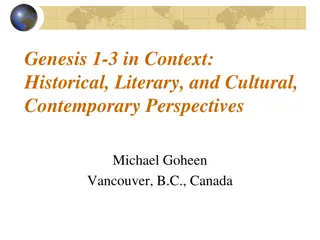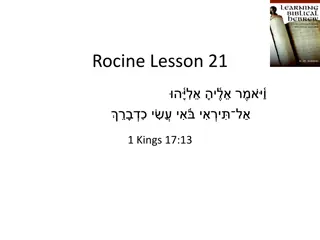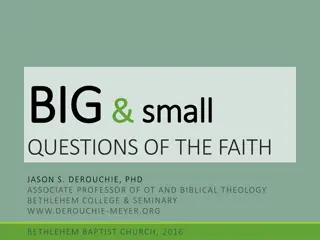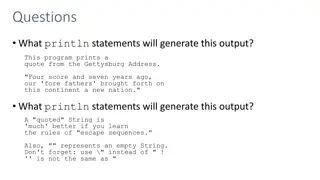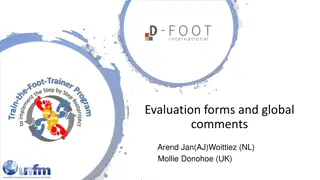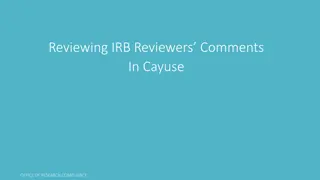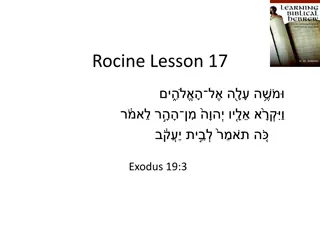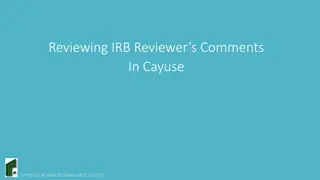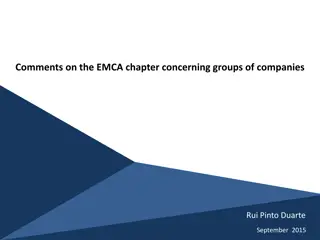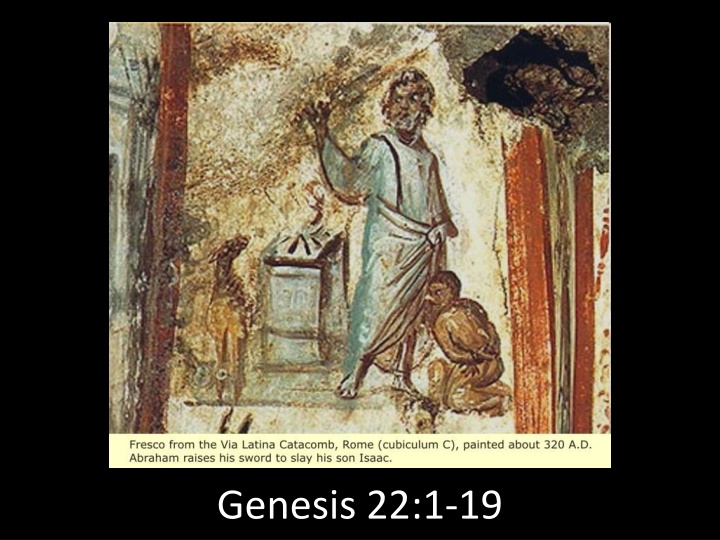
The Testing of Abraham in Genesis 22:1-19 Discourse Study
Explore the discourse structure in Genesis 22:1-19, focusing on the testing of Abraham as a distinct narrative within the larger context of his life. Discover how discourses are intertwined in a hierarchical manner, with smaller embedded discourses shaping the overall historical narrative. Uncover the resolution that follows the climax of the testing of Abraham, reflecting on the theological implications within the text.
Download Presentation

Please find below an Image/Link to download the presentation.
The content on the website is provided AS IS for your information and personal use only. It may not be sold, licensed, or shared on other websites without obtaining consent from the author. If you encounter any issues during the download, it is possible that the publisher has removed the file from their server.
You are allowed to download the files provided on this website for personal or commercial use, subject to the condition that they are used lawfully. All files are the property of their respective owners.
The content on the website is provided AS IS for your information and personal use only. It may not be sold, licensed, or shared on other websites without obtaining consent from the author.
E N D
Presentation Transcript
DEFINITION: A discourse is a group of expressions linked together from a beginning to an ending so that they develop an idea in some orderly fashion.
Genesis 22:1-19 The Testing of Abraham Gen 22:9-13 Gen 22:1-3 Gen 22:14-19 Gen 22:4-8
Genesis 22:1-19 The Testing of Abraham v 1 Gen 22:9-13 Gen 22:1-3 Gen 22:14-19 Gen 22:4-8
Genesis 22:1-19 The Testing of Abraham v 1 Gen 22:9-13 Gen 22:1-3 This phrase marks or signals the beginning of a small, distinct discourse (the testing of Abraham) in the larger Historical Narrative discourse of Abraham s life (Genesis 12-25). Discourses are often arranged in a hierarchy in which one large discourse is made of several smaller, embedded discourses. Gen 22:14-19 Gen 22:4-8
Genesis 22:1-19 The Testing of Abraham v 1 v 12 Gen 22:9-13 Gen 22:1-3 The testing of Abraham is finished in verse 12, but there is still the resolution to follow. Gen 22:14-19 Gen 22:4-8
Genesis 22:1-19 The Testing of Abraham v 1 v 12 Gen 22:9-13 Gen 22:1-3 The Resolution An important part of many stories takes place immediately after the story s climax, after the tension within a story is released. This is especially evident in the Gospel of John where events are often followed by commentary making more explicit the message (theology) of the narrative. Gen 22:14-19 Gen 22:4-8
Genesis 22:1-19 The Testing of Abraham v 1 v 12 Gen 22:9-13 Gen 22:1-3 The Resolution An important part of many stories takes place immediately after the story s climax, after the tension within a story is released. This is especially evident in the Gospel of John where events are often followed by commentary making more explicit the message (theology) of the narrative. Gen 22:14-19 Gen 22:4-8 v 16 In verses 16 18, the angel of YHWH speaks to Abraham, informing Abraham of the promises that belong to him as a result of passing the test. In verse 19, Abraham returns to his servants and his home. Verse 19 brings the resolution and hence, the story to a close. v 17 v 18 v 19
Genesis 22:1-19 The Testing of Abraham v 1 v 12 Gen 22:9-13 Gen 22:1-3 Gen 22:14-19 Gen 22:4-8 v 16 The next verse (v 20) reads just like verse 1. Here we have, once again, a faithful marker v 17 of another episode in the story of Abraham s life, confirming that verse 19 is indeed the end of the Abraham is Tested story. v 18 v 19 v 20
Genesis 22:1-19 The Testing of Abraham Gen 22:9-13 Gen 22:1-3 Tracing the Mainline Gen 22:14-19 Gen 22:4-8
Genesis 22:1-19 The Testing of Abraham Gen 22:9-13 Gen 22:1-3 The wayyiqtols form the skeleton upon which the details of the story hang. Gen 22:14-19 Gen 22:4-8
Genesis 22:1-19 The Testing of Abraham Gen 22:9-13 Gen 22:1-3 Notice how many are Gen 22:14-19 Gen 22:4-8
Genesis 22:1-19 The Testing of Abraham Gen 22:9-13 Gen 22:1-3 This is evidence that much of the detail in Biblical Hebrew narrative is carried Gen 22:4-8 by dialogue. Gen 22:14-19
Genesis 22:1-3 child-sacrifice demanding Canaanite gods. Definite Article on Elohim It is very common for to have the definite article in Hebrew. The Canaanites worshipped other gods, some of which required child sacrifice. The use of the definite article in this and succeeding verses may be to clarify that this test did not originate with any of the
Genesis 22:1-3 What construction do we have here?
Genesis 22:1-3 X-Qatal Topicalization and it was Elohim who was a tester of Abraham
Genesis 22:1-3 X-Qatal Topicalization and it was Elohim who was a tester of Abraham X-Qatal as Summary Statement We can further specify the function of the X-qatal in this passage because it precedes the beginning of the episode s wayyiqtol string. In such a case the X-qatal often summarizes, like a headline, what is to follow. Note that, though the in v 1 is a wayyiqtol, its function is Transition Marker not Historical Narrative Mainline.
Genesis 1:1-3 v1 Let s look at another example: Genesis 1:1-3 Where is the first H.N. Mainline wayyiqtol? What constructions precede it? v2 v3
Genesis 1:1-3 X-Qatal v1 X-Qatal v2 Verbless clause Participle Wayyiqtol v3
Genesis 1:1-3 Topicalization / Summary X-Qatal v1 Topicalization X-Qatal v2 Scene setting Verbless clause Backgrounded activities Participle H.N. Mainline Wayyiqtol v3
Genesis 1:1-3 Topicalization / Summary X-Qatal v1 Topicalization X-Qatal v2 Scene setting Verbless clause Backgrounded activities Participle H.N. Mainline Wayyiqtol v3 The first X-Qatal fits well as a summary statement for the following narrative.
Genesis 1:1-3 Topicalization / Summary X-Qatal v1 Topicalization X-Qatal v2 Scene setting Verbless clause Backgrounded activities Participle H.N. Mainline Wayyiqtol v3 The first X-Qatal fits well as a summary statement for the following narrative. The second X-Qatal doesn t summarize the following narrative but if a wayyiqtol were used here it would make this the first event in the narrative and be translated something like the earth became formless and void which means something quite different than now it was the earth that was formless and void . The use of an X-Qatal here rather than a wayyiqtol makes it less likely that the author had in mind some sort of gap theory , where verse 1 refers to a previous creation and verse 2 the destruction of that creation. Also, verse 1 functioning as a summary statement argues against a gap theory . In the text as it stands the first action comes with the wayyiqtol in verse 3.
Genesis 1:1-3 Topicalization / Summary X-Qatal v1 Topicalization X-Qatal v2 Scene setting Verbless clause Backgrounded activities Participle H.N. Mainline Wayyiqtol v3 The first X-Qatal fits well as a summary statement for the following narrative. The second X-Qatal doesn t summarize the following narrative but if a wayyiqtol were used here it would make this the first event in the narrative and be translated something like the earth became formless and void which means something quite different than now it was the earth that was formless and void . The use of an X-Qatal here rather than a wayyiqtol makes it less likely that the author had in mind some sort of gap theory , where verse 1 refers to a previous creation and verse 2 the destruction of that creation. Also, verse 1 functioning as a summary statement argues against a gap theory . In the text as it stands the first action comes with the wayyiqtol in verse 3. The first 2 X-Qatals, the verbless clause in 2b, and the participle in 2c, provide 4 lines of summary and background material for the beginning of the narrative action in verse 3.
Genesis 22:1-3 What discourse genre is this?
Genesis 22:1-3 What discourse genre is this? Unmitigated Hortatory Discourse 3 imperatives 0 weqatals
Genesis 22:1-3 What is the syntax, function and translation of this qatal?
Genesis 22:1-3 What is the syntax, function and translation of this qatal? Qatal in dependent clause Relative past background which you love not which you had loved or which you have loved (Note that roots like that refer to emotional and mental activity usually require present tense translations.)
Genesis 22:1-3 To the extent that qatal can be viewed as an atributizer, both main actors in this narrative are labelled within the first 2 verses. Elohim the tester (X-Qatal in v 1) Abraham the lover (Qatal in dep. clause in v 2) The tester will test the love of the lover.
Genesis 22:1-3 What construction is this?
Genesis 22:1-3 What construction is this? Yiqtol in dependent clause (not participle or qatal) Relative non-past background which I will tell you or which I tell you
Genesis 22:1-3 What construction is this? What construction is this? Yiqtol in dependent clause (not participle or qatal) Relative non-past background which I will tell you or which I tell you
Genesis 22:1-3 What construction is this? Qatal in dependent clause (not yiqtol) Relative past background which God had told him What construction is this? Yiqtol in dependent clause (not participle or qatal) Relative non-past background which I will tell you or which I tell you
Genesis 22:1-3 What construction is this? Qatal in dependent clause (not yiqtol) Relative past background which God had told him By this point Abraham knows at least the place, even if he doesn t know which mountain yet. What construction is this? Yiqtol in dependent clause (not participle or qatal) Relative non-past background which I will tell you or which I tell you
Genesis 22:4-8 What is this?
Genesis 22:4-8 What is this? Not a clause (no subject and predicate) It s a hanging fragment
Genesis 22:4-8 What is this? Not a clause (no subject and predicate) It s a hanging fragment Rocine says it interrupts the flow of the wayyiqtol string, and thereby creates suspense. We might translate it It was on the third day.
Genesis 22:4-8 What genre?
Genesis 22:4-8 What genre? 1 imperative 3 cohortatives Hortatory
Genesis 22:4-8 What genre? X-Cohortative
Genesis 22:4-8 What genre? X-Cohortative X-Cohortative As for me and the lad, let us go or As for me and the lad, we will go The topicalization of the X-Cohortative switches the focus from the two servants to Abraham and his son: you two stay here, I and the lad will go up there
Genesis 22:4-8 What genre? X-Cohortative The 3 cohortatives are evidence of Abraham s faith in God. He is a lover of his son. He already knows what God has called him to do. And he expects (or at a minimum wishes) to return with his son alive.
Genesis 22:4-8 What genre? X-Cohortative The 3 cohortatives are evidence of Abraham s faith in God. He is a lover of his son. He already knows what God has called him to do. And he expects (or at a minimum wishes) to return with his son alive. But Abraham is also a lover of God. He does not begrudge God. He characterizes what will happen on the mountain as worship. Also note he says we will worship, not I will worship. The narrator has already tipped his hat regarding the outcome of the test.
Genesis 22:4-8 There is a conspicuous similarity between this word and verse two s . V 2a
Genesis 22:4-8 Notice the character switching. First speaker and addressee are clearly identified (Isaac and Abraham). Then speakers alternate with minimal encoding.
Genesis 22:4-8 When there is over-encoding we should ask why.


![❤[PDF]⚡ Escaping from Eden: Does Genesis Teach that the Human Race was Created](/thumb/21697/pdf-escaping-from-eden-does-genesis-teach-that-the-human-race-was-created.jpg)

